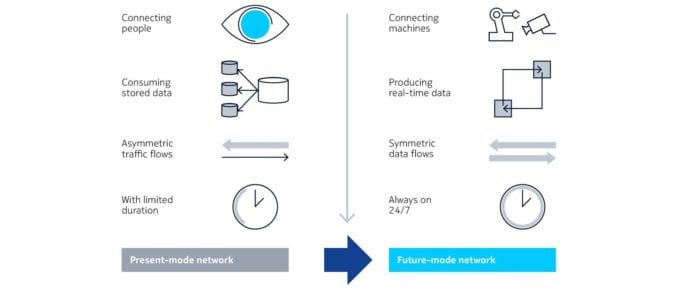The digital era of 5G and the cloud is triggering a new cycle of network investment to address emerging opportunities such as the digital enterprise, Industry 4.0 and smart cities. There is a big opportunity for private 5G services for enterprises — especially those needing edge computing for critical machine-to-machine communications and other Industry 4.0 applications. The need for these services is introducing new players into the WAN market that have the luxury of starting afresh with a very different kind of network.
Incumbent communications services providers will play a major role in building future public 5G networks. But only the biggest operators will have the resources to pursue both the consumer and enterprise in all markets. There is also a sizeable opportunity for other players to provide a range of smart, virtualized network connectivity services to support edge cloud and private 5G enterprise services.
The big webscale players behind the public cloud, such as AWS, Azure, Facebook, Google and Oracle, are also making forays into private cloud services — but this is a very big market. For distributed edge clouds, co-location providers may be even better positioned with an already large and distributed private hosting footprint and pre-existing peering agreements already playing in their favor. To leverage their advantage, they will need to build a programmable wide-area data-interconnection fabric.
Traffic in the current, video-dominated WAN flows vertically from central clouds out to viewers, ramifying in a hierarchical way. In the optical layer, rings provide 1:1 redundancy for transporting video to the edge routers for distribution. Because it is high-volume, low-value, best-effort traffic, this method of protection is very costly, since 50% of capacity is on standby as backup.

Figure 1. Use cases are shifting demand for different network performance characteristics.
In the new machine-to-machine network, high value traffic flows horizontally between edge clouds just as much as between central clouds and the edge. A process running in the central cloud, for instance, might have to shift to an edge cloud to meet low latency requirements from a locally running automation application. Alternatively, a process may have to move from edge cloud to edge cloud to follow the application. Along with this agility and scalability, there is a primacy on availability and meeting stringent SLAs.

Figure 2. Meeting these different performance characteristics will require different network architectures with an emphasis on a programmable interconnection fabric.
These highly variable demands and shifting traffic flows will require the wide area network, which is providing the edge cloud interconnection fabric, to be highly scalable and programmable. The shifting of processes from core to edge or edge to edge has to happen so quickly that only an automated process will work. This must happen both at the IP layer, as in the data center, but also in the optical layer because transport resources are relatively scarce and expensive in the WAN.
Fortunately, there are new technologies at both layers that can make this possible. At the IP layer, they include segment routing and, at the optical layer, CDC-F wavelength routing and packet optical transport. Both layers also benefit from streaming telemetry and programmable interfaces to enable the WAN SDN controller to keep the two layers coordinated.
Instead of employing a hierarchical IP aggregation topology over interconnected rings with 1+1 protection at the optical layer for all traffic classes, a flexible any-to-any optical mesh network with an intelligent GMPLS control plane will provide a better match and enable a more differentiated, multi-layer protection strategy.
Ultra-reliable, low latency transport for mission-critical traffic can be addressed by combining 1+1 protection switching with dynamic restoration of a new backup path to protect against multiple failures. Premium enterprise traffic can be cost-efficiently assured against multiple failures by using dynamic restoration with a guaranteed pool of shared backup resources, with the option of using MPLS fast reroute at the IP layer. Moreover, high volume, best-effort internet and streaming video traffic can be cost-effectively protected by load-balancing IP traffic over 1+N unprotected but physically disjoint optical links to avoid single points of failure.
For cloud providers that are building their own data center interconnection fabric, employing this SDN programmability across both layers enables them to use the strengths of both layers to their advantage. They can program least-cost routing to automatically send some types of traffic through the optical layer and others through the routed network. It provides greater reliability for the mission-critical traffic that really counts, but provides less expensive, best effort services for consumer-level traffic, such as video.
Providing enterprise customers with a seamless, highly responsive global edge cloud platform is a big opportunity. Industry 4.0, with its convergence of robotics, IoT and AI/ML, will be hugely disruptive across almost every industry, from mining to healthcare, and it will require the ubiquitous, low latency coverage of 5G to really take off. A flexible, programmable data center interconnection fabric that integrates both IP and optical layers will play a key role in making this possible.

